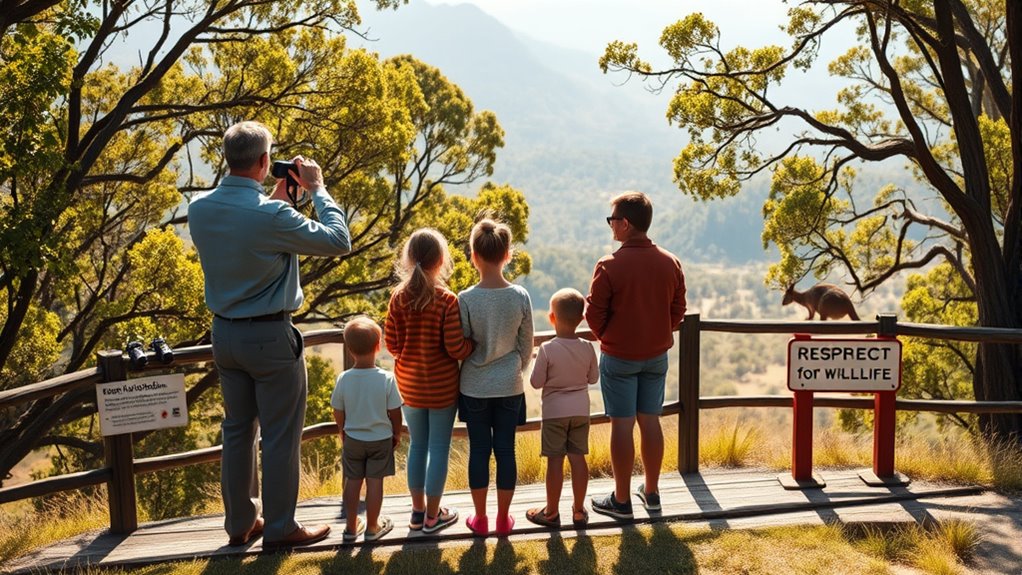When viewing wildlife in the Blue Mountains, keep a safe distance of at least 100 meters from larger animals. Stay quiet and move slowly to avoid startling them. Never feed wildlife; it disrupts their natural behaviors and diet. Stick to marked trails to protect fragile ecosystems and report any injured or distressed animals to authorities for proper care. These simple tips help preserve both the animals’ well-being and their habitats. There’s more to explore about responsible viewing practices.
Key Takeaways
- Maintain a minimum distance of 100 meters from larger animals to ensure their well-being and natural behaviors.
- Keep noise levels low and move slowly to avoid startling wildlife and enhance your observation experience.
- Do not feed wildlife to preserve their natural foraging instincts and maintain ecosystem balance.
- Report any injured or distressed animals to authorities for proper care and conservation efforts.
- Stick to designated paths to protect fragile ecosystems and minimize disturbance to wildlife habitats.

When you explore the stunning landscapes of the Blue Mountains, it is essential to remember that you’re sharing this beautiful habitat with its native wildlife. Observing animals in their natural environment can be a remarkable experience, but it comes with responsibilities. Respecting wildlife and their habitats guarantees that future visitors can enjoy these moments just like you.
First and foremost, keep a safe distance from animals. Approaching too closely can stress them out and disrupt their natural behaviors. You might be eager to snap that perfect photo, but remember that the well-being of the animal should come first. Use your zoom lens for photography, allowing you to capture stunning images without intruding upon their space. Familiarize yourself with photography guidelines for wildlife; they often recommend maintaining a minimum distance of at least 100 meters from larger animals, such as kangaroos or wallabies. This not only protects the animals but also enhances your experience, as you’ll observe them behaving naturally.
Keep a respectful distance from wildlife to ensure their well-being and enhance your observation experience.
When you’re out for animal observation, keep noise to a minimum. Loud sounds can startle wildlife and scare them away, ruining your chance to see them up close. Instead, engage in quiet conversations with your companions and move slowly to avoid disturbing the surroundings. This gentle approach increases your chances of spotting more species, adding to the thrill of your adventure.
Avoid feeding wildlife, no matter how tempting it might be. While you might think you’re helping, feeding animals can lead to unhealthy dependencies on humans and disrupt their natural foraging instincts. Instead, enjoy the view and let them thrive on their natural diet. If you happen to witness an animal that seems injured or in distress, report it to the appropriate authorities instead of attempting to intervene yourself.
Remember to stick to designated paths when hiking. Straying off trails can damage fragile ecosystems and disturb the habitats of the animals that live there. Maintaining this balance is vital for preserving the beauty and integrity of the Blue Mountains.
Frequently Asked Questions
What Types of Wildlife Can I Expect to See in the Blue Mountains?
In the Blue Mountains, you can expect to see a variety of wildlife, including numerous bird species like lyrebirds and cockatoos. Keep your eyes peeled for marsupial sightings too, as you might spot kangaroos, wallabies, and even the elusive koala. Early mornings and late afternoons are the best times for wildlife encounters, so grab your binoculars and enjoy the stunning natural beauty while observing these incredible creatures in their habitat.
Are There Specific Times of Year That Are Best for Wildlife Viewing?
Yes, specific times of year are definitely better for wildlife viewing. In spring, you’ll witness breeding season, with many animals active and visible. During autumn, keep an eye out for seasonal migration; birds and some mammals travel through the area. Early mornings and late afternoons offer the best chances to spot wildlife, as animals are more active during these cooler times. Plan your visits around these seasons for an unforgettable experience!
Can I Bring My Pet While Wildlife Viewing in the Blue Mountains?
You can’t bring your pet while wildlife viewing in the Blue Mountains. Just like a scene from a classic nature documentary, where harmony reigns, it’s vital to prioritize pet safety and local wildlife. If you do decide to visit, make sure to follow leash regulations strictly. Not only does this protect the animals, but it also guarantees your pet stays safe and doesn’t disturb the delicate ecosystem surrounding you. Enjoy the beauty responsibly!
What Should I Do if I Encounter an Injured Animal?
If you encounter an injured animal, stay calm and assess the situation. Don’t approach the animal, as it might be scared or aggressive. Follow rescue procedures by contacting a local wildlife rehabilitation center or animal control. They’ll guide you on what to do next. Make sure to report the incident using the proper reporting protocols, providing details about the animal’s location and condition to guarantee it gets the help it needs.
Are There Guided Tours for Wildlife Viewing Available in the Area?
Yes, there are plenty of guided tour options for wildlife viewing in the area. You’ll find various companies offering experiences led by wildlife expert guides who can enhance your understanding of the local fauna. These tours often take you to prime viewing spots, ensuring you have the best chance to see unique species. It’s a fantastic way to connect with nature while benefiting from the knowledge and insights of seasoned professionals.
Conclusion
As you explore the stunning Blue Mountains, remember that “take only pictures, leave only footprints.” By respecting wildlife and their habitat, you contribute to preserving the beauty for future generations. Keep your distance, avoid feeding animals, and follow designated paths to guarantee both your safety and theirs. With a little mindfulness, you can enjoy unforgettable moments in nature while fostering a harmonious relationship with the incredible creatures that call this region home. Happy wildlife watching!










